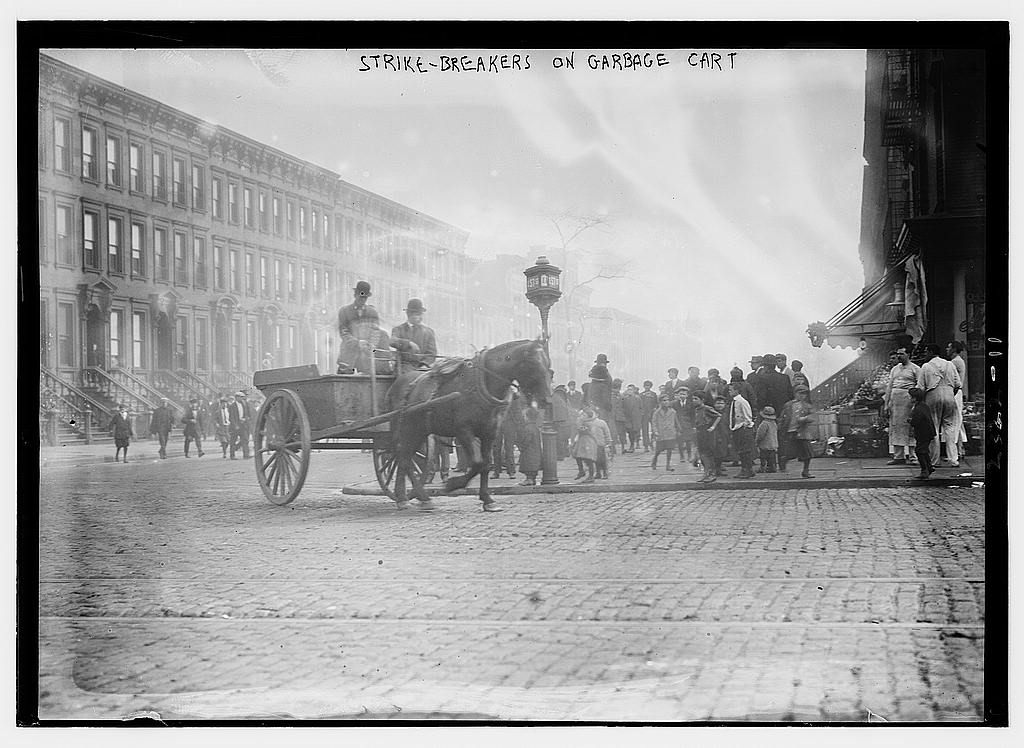The Evolution of the Garbage Truck
Garbage trucks have evolved from glorified dump trucks to sophisticated engines of trash transport.

We’ve come a long way (in terms of garbage hauling), baby! (Photo: Jason Lawrence/CC BY 2.0)

Garbage has always needed a way to get from someone’s property to its final destination—and the iconic garbage trucks have been evolving right with human technology.

In the 1800s, the preferred method was horse-drawn carts, whose contents also carried human waste in the pre-sewer “night soil” days. But by the 20th century they were replaced by pick-up style trucks which would fill their beds with trash and take it to the dump. While a simple and effective method, it posed a number of problems, including the smell of exposed waste, trash flying out of the back while they drove, and workers having to lift heavy loads into the too-high bed of the truck. To combat the sanitation issues, covered trucks began to roll out in Europe in the 1920s, and the trend came to the U.S. shortly thereafter.
However the problem of lifting the trash up into the vehicles was still an issue, so more mechanical solutions were devised, specifically the external hopper truck.
First introduced in the form of the Heil Collecto, which hit the streets in 1929, this model had a bucket hopper on the side of the truck that would lift trash and dump it into the back of the truck through an opening in the top. This innovative new truck became one of the first standard trucks, which paved the way for our more modern trucks.

A horse-drawn garbage cart (Photo: Library of Congress/LC-B2- 2322-11)
In the mid-1930s the invention of the dumpster once again evolved the face of waste removal trucks. Invented by George Dempster (yep, that’s why they’re called “dumpsters”), the Dempster-Dumpster system used large bins that garbage men would fill with trash, and that would then be loaded into body using machinery on the trucks.
By the 1950s, this system would evolve into the front-loading commercial garbage trucks we still see everywhere today, the ones that lift dumpsters up over the cab and unload the contents into the back.
Watch a modern rear-loading truck eat a car, just for fun. (Photo: Youtube)
While the Dempster-Dumpster system revolutionized how garbage got onto the truck, another major innovation arrived in 1938, that made the garbage in the truck more efficient as well. The Barwood Load Packer was the first model of garbage truck to feature an on-board compacting system that smashed the garbage down, allowing the vehicle to haul more during each trip. The basic principle behind these compactors, which hasn’t changed much since its invention in the 1930s, is that a massive blade powered by hydraulic cylinders scoops the garbage up against a panel in the body of the truck. This innovation also introduced the rear-loader garbage truck design, where garbage is thrown in the back of the truck by workers who ride on the outside.
The compacting system soon became the standard among garbage trucks, and by the 1970s, front-loader trucks (for commercial dumpsters and the like) and rear-loader trucks (for residential pick up), filled garbage disposal fleets across the country.
Since these central developments, garbage trucks have continued to evolve in small, but important ways. “Automation started phasing in during the 1980s, primarily in the Sun Belt,” says Phil Allen, Vice-President of Sales and Marketing for New Way, the third largest garbage truck manufacturer in the United States. As the big green “wheelie bins” became the residential standard, automated arms began to appear on the sides of trucks that could simply pick up the plastic bins and dump them without a garbageman even having to mess with them. “The trend in rear-loaders is down.” Allen told us. “It used to be there’d be three men on a rear-loader. Then it went down to two men.” One person would drive the truck while the other one or two garbagemen would hop off and toss the garbage in the back.
However this system has proved to be fairly dangerous with employees hurting themselves coming off the trucks or picking up sharp, hazardous trash. These automated arms eliminated a number of worker-related issues. “It reduced the workman’s comp claims, it gave the driver a comfortable job. It’s a nice job now,” said Allen.
The rising trend of organic waste collection is poised to once again change the face of the garbage truck, or at least the guts. New Way has developed a type of truck, called the Roto-Pak, that has gotten rid of the traditional hydraulic compacting blades and replaced them with a large auger that grinds the trash in the truck. “It’s basically like going through a large sausage grinder,” said Allen. He told us that the company developed the technology to handle organic matter, which tends to get into every crack and crevasse of more complicated machines.
For the time being, organic waste pick up has not picked up enough steam for the new auger-driven trucks to replace the entire old guard, but it may be the way of the future if Allen is to be believed. “Not enough cities and communities are [taking separate organic waste], so we started putting garbage in it,” he says. “Holy cow, it’s a hell of a garbage truck.”









Follow us on Twitter to get the latest on the world's hidden wonders.
Like us on Facebook to get the latest on the world's hidden wonders.
Follow us on Twitter Like us on Facebook